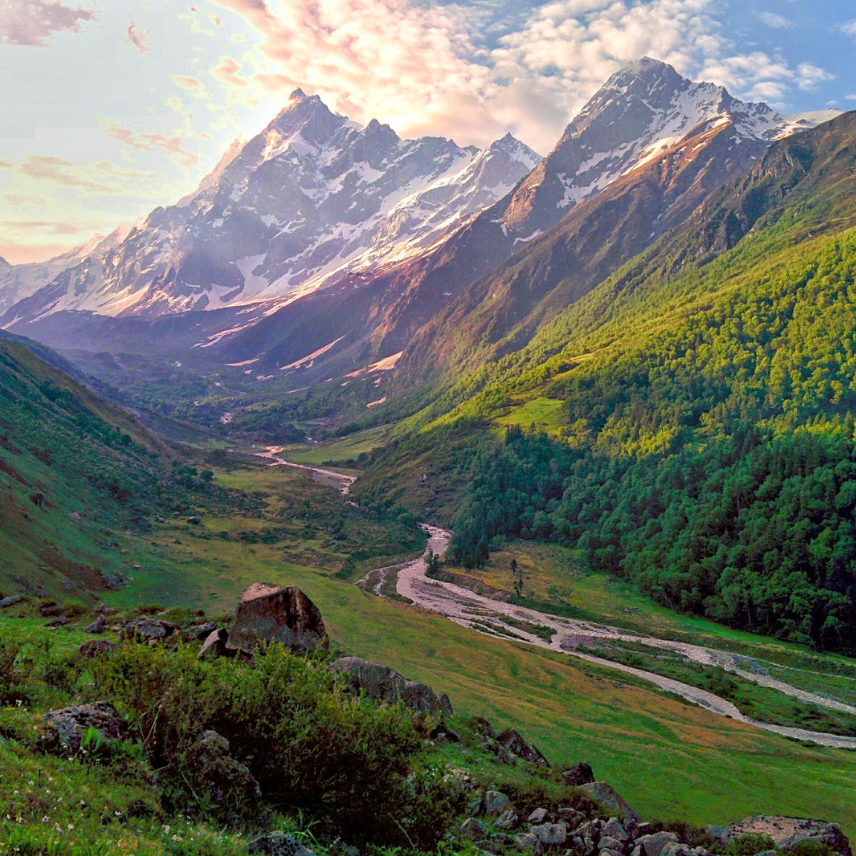Nestled in the picturesque valley of the Garhwal Himalayas, Har Ki Doon is a lesser-known yet enchanting destination that captivates visitors with its stunning natural beauty and serene atmosphere. Located at an elevation of approximately 3,566 meters, Har Ki Doon offers an idyllic retreat for nature enthusiasts, adventure seekers, and spiritual travelers alike.
Nestled in the picturesque valley of the Garhwal Himalayas, Har Ki Doon is a lesser-known yet enchanting destination that captivates visitors with its stunning natural beauty and serene atmosphere. Located at an elevation of approximately 3,566 meters, Har Ki Doon offers an idyllic retreat for nature enthusiasts, adventure seekers, and spiritual travelers alike.
About Har Ki Doon
Har Ki Doon is a pristine valley situated in the Uttarkashi district of Uttarakhand, India. Known for its striking landscape and tranquil environment, the valley is often referred to as the "Valley of Gods." The name is derived from the Sanskrit word "Har," which means Lord Shiva, and "Doon," which means valley. The region is blessed with lush meadows, dense forests, and majestic snow-capped peaks, making it a perfect destination for those looking to escape the hustle and bustle of city life.
Historical and Cultural Significance
Har Ki Doon has deep-rooted cultural significance, with local folklore and ancient traditions shaping its identity. The valley is believed to be the mythical abode of the Pandavas from the Mahabharata, adding to its spiritual allure. The surrounding villages, inhabited by the Swargarohini and Jaunsari tribes, maintain a rich cultural heritage that reflects in their customs, festivals, and traditional architecture.
Why Visit Har Ki Doon?
Har Ki Doon is not just a visual treat but also a sanctuary for those seeking peace and solitude. Its undisturbed natural environment provides an opportunity to reconnect with nature and enjoy the simpler things in life. The valley's untouched beauty and serene ambiance make it an ideal destination for a variety of outdoor activities, including trekking, camping, and nature photography.
Weather and Best Time to Visit
Har Ki Doon experiences a temperate climate with distinct seasons. The best time to visit is from May to June and September to October. During these months, the weather is pleasant, with clear skies and moderate temperatures, making it ideal for trekking and outdoor exploration. Winters can be harsh with heavy snowfall, and the monsoon season (July to August) brings heavy rains, which can make travel challenging.
What to See in Har Ki Doon
The valley's charm lies in its natural beauty and pristine landscapes. Some of the key attractions include:
- Har Ki Doon Valley: The heart of the region, known for its picturesque meadows, snow-capped peaks, and lush greenery.
- Swargarohini Peak: A prominent peak that offers stunning panoramic views of the surrounding mountains and is considered sacred by locals.
- Osla Village: A charming village en route to Har Ki Doon, known for its traditional architecture and vibrant culture.
- Jaundhar Glacier: A breathtaking glacier that can be reached via a scenic trek from Har Ki Doon, offering magnificent views of the Himalayas.
Things to Do in Har Ki Doon
Visitors to Har Ki Doon can enjoy a range of activities that cater to different interests:
- Trekking: The trek to Har Ki Doon from Sankri is a popular activity, offering a blend of adventure and natural beauty. The trail passes through dense forests, gurgling streams, and quaint villages.
- Camping: Camping in the valley provides an opportunity to experience the great outdoors and enjoy the serene environment under the starlit sky.
- Photography: The stunning landscapes and diverse flora and fauna make Har Ki Doon a paradise for photographers.
- Cultural Exploration: Interacting with local villagers and exploring their traditions and way of life offers a unique cultural experience.
Accommodation Options
Accommodation in Har Ki Doon is basic but comfortable, primarily catering to trekkers and nature enthusiasts. Options include:
- Camping Sites: Temporary camps set up along the trek route and in the valley.
- Guesthouses: Basic guesthouses in nearby villages such as Sankri and Osla.
- Dharamshalas: Pilgrim lodges and simple accommodations in the vicinity.
It's advisable to book accommodations in advance, especially during peak trekking seasons, as availability can be limited.
Dining and Shopping
Dining options in Har Ki Doon are modest, with most establishments offering simple vegetarian meals. The focus is on providing basic nourishment rather than gourmet experiences. For shopping, the area around Sankri and Osla offers a few local shops selling essential supplies, traditional handicrafts, and souvenirs.
Practical Information
- Mobile Network: Connectivity may be limited in Har Ki Doon due to its remote location. It's best to inform family and friends of your travel plans in advance.
- Bank/ATM: Basic financial services are available in Sankri, the base camp for the trek.
- Medical Facilities: Basic medical services are available in Sankri. It's advisable to carry any necessary medications and consult a medical professional before embarking on the trek.
- Transport: Har Ki Doon can be reached via a trek from Sankri, which is accessible by road from major cities in Uttarakhand.
Conclusion
Har Ki Doon is a hidden gem in the Garhwal Himalayas that offers a unique blend of natural beauty, adventure, and cultural richness. Whether you're a trekker seeking new horizons, a nature lover in search of tranquility, or someone interested in exploring traditional Himalayan culture, Har Ki Doon promises an unforgettable experience that will leave you with lasting memories. Embrace the serene beauty and spiritual essence of this enchanting valley and discover a world beyond the ordinary.



